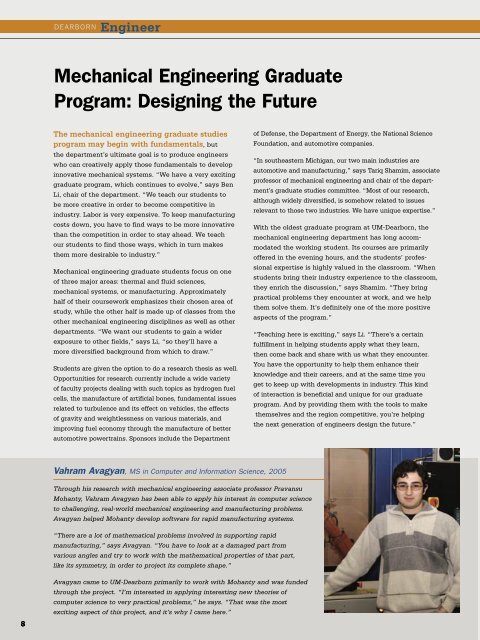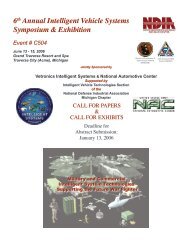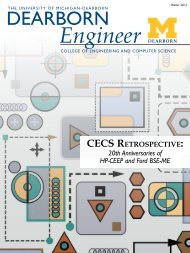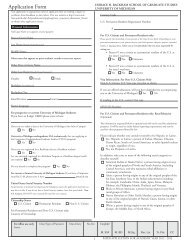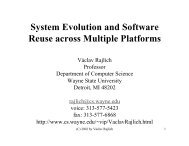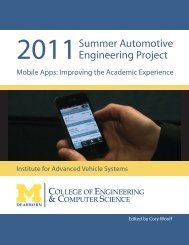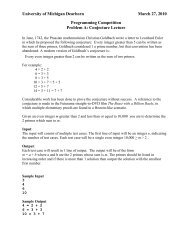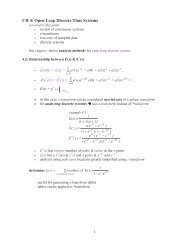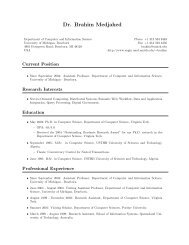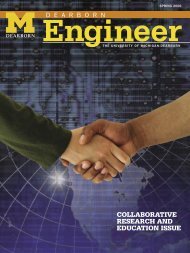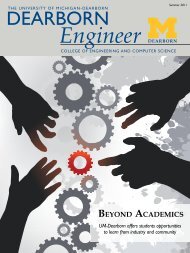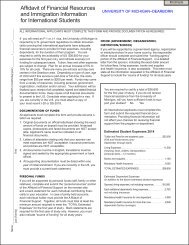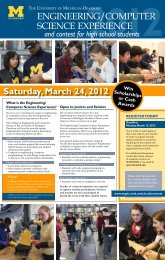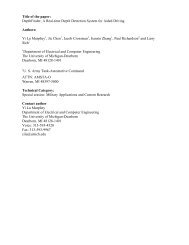Dearborn Engineer, Fall 2005 - College of Engineering & Computer ...
Dearborn Engineer, Fall 2005 - College of Engineering & Computer ...
Dearborn Engineer, Fall 2005 - College of Engineering & Computer ...
Create successful ePaper yourself
Turn your PDF publications into a flip-book with our unique Google optimized e-Paper software.
DEARBORN <strong>Engineer</strong><br />
Mechanical <strong>Engineer</strong>ing Graduate<br />
Program: Designing the Future<br />
The mechanical engineering graduate studies<br />
program may begin with fundamentals, but<br />
the department’s ultimate goal is to produce engineers<br />
who can creatively apply those fundamentals to develop<br />
innovative mechanical systems. “We have a very exciting<br />
graduate program, which continues to evolve,” says Ben<br />
Li, chair <strong>of</strong> the department. “We teach our students to<br />
be more creative in order to become competitive in<br />
industry. Labor is very expensive. To keep manufacturing<br />
costs down, you have to find ways to be more innovative<br />
than the competition in order to stay ahead. We teach<br />
our students to find those ways, which in turn makes<br />
them more desirable to industry.”<br />
Mechanical engineering graduate students focus on one<br />
<strong>of</strong> three major areas: thermal and fluid sciences,<br />
mechanical systems, or manufacturing. Approximately<br />
half <strong>of</strong> their coursework emphasizes their chosen area <strong>of</strong><br />
study, while the other half is made up <strong>of</strong> classes from the<br />
other mechanical engineering disciplines as well as other<br />
departments. “We want our students to gain a wider<br />
exposure to other fields,” says Li, “so they’ll have a<br />
more diversified background from which to draw.”<br />
Students are given the option to do a research thesis as well.<br />
Opportunities for research currently include a wide variety<br />
<strong>of</strong> faculty projects dealing with such topics as hydrogen fuel<br />
cells, the manufacture <strong>of</strong> artificial bones, fundamental issues<br />
related to turbulence and its effect on vehicles, the effects<br />
<strong>of</strong> gravity and weightlessness on various materials, and<br />
improving fuel economy through the manufacture <strong>of</strong> better<br />
automotive powertrains. Sponsors include the Department<br />
<strong>of</strong> Defense, the Department <strong>of</strong> Energy, the National Science<br />
Foundation, and automotive companies.<br />
“In southeastern Michigan, our two main industries are<br />
automotive and manufacturing,” says Tariq Shamim, associate<br />
pr<strong>of</strong>essor <strong>of</strong> mechanical engineering and chair <strong>of</strong> the department’s<br />
graduate studies committee. “Most <strong>of</strong> our research,<br />
although widely diversified, is somehow related to issues<br />
relevant to those two industries. We have unique expertise.”<br />
With the oldest graduate program at UM-<strong>Dearborn</strong>, the<br />
mechanical engineering department has long accommodated<br />
the working student. Its courses are primarily<br />
<strong>of</strong>fered in the evening hours, and the students’ pr<strong>of</strong>essional<br />
expertise is highly valued in the classroom. “When<br />
students bring their industry experience to the classroom,<br />
they enrich the discussion,” says Shamim. “They bring<br />
practical problems they encounter at work, and we help<br />
them solve them. It’s definitely one <strong>of</strong> the more positive<br />
aspects <strong>of</strong> the program.”<br />
“Teaching here is exciting,” says Li. “There’s a certain<br />
fulfillment in helping students apply what they learn,<br />
then come back and share with us what they encounter.<br />
You have the opportunity to help them enhance their<br />
knowledge and their careers, and at the same time you<br />
get to keep up with developments in industry. This kind<br />
<strong>of</strong> interaction is beneficial and unique for our graduate<br />
program. And by providing them with the tools to make<br />
themselves and the region competitive, you’re helping<br />
the next generation <strong>of</strong> engineers design the future.”<br />
Vahram Avagyan, MS in <strong>Computer</strong> and Information Science, <strong>2005</strong><br />
Through his research with mechanical engineering associate pr<strong>of</strong>essor Pravansu<br />
Mohanty, Vahram Avagyan has been able to apply his interest in computer science<br />
to challenging, real-world mechanical engineering and manufacturing problems.<br />
Avagyan helped Mohanty develop s<strong>of</strong>tware for rapid manufacturing systems.<br />
“There are a lot <strong>of</strong> mathematical problems involved in supporting rapid<br />
manufacturing,” says Avagyan. “You have to look at a damaged part from<br />
various angles and try to work with the mathematical properties <strong>of</strong> that part,<br />
like its symmetry, in order to project its complete shape.”<br />
8<br />
Avagyan came to UM-<strong>Dearborn</strong> primarily to work with Mohanty and was funded<br />
through the project. “I’m interested in applying interesting new theories <strong>of</strong><br />
computer science to very practical problems,” he says. “That was the most<br />
exciting aspect <strong>of</strong> this project, and it’s why I came here.”


